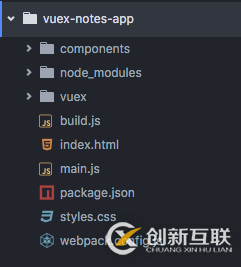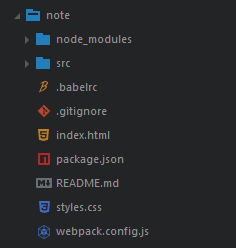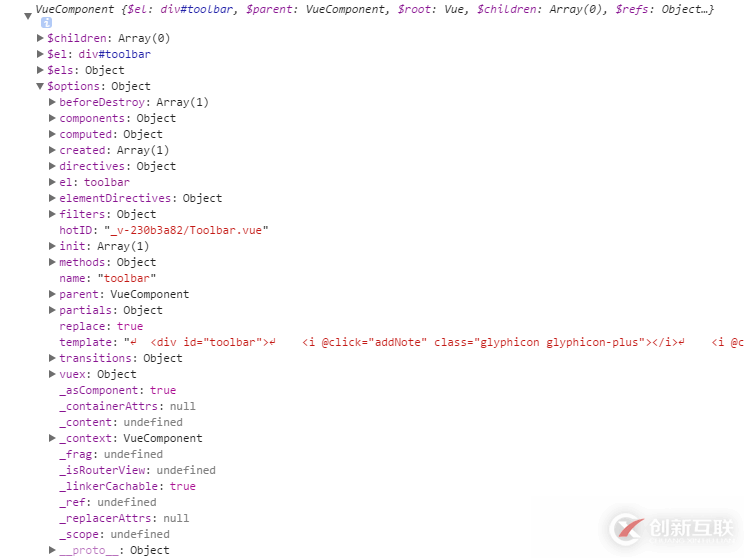如何使用vuejs2.0+vuex2.0构建记事本应用-创新互联
小编给大家分享一下如何使用vuejs2.0+vuex 2.0构建记事本应用,相信大部分人都还不怎么了解,因此分享这篇文章给大家参考一下,希望大家阅读完这篇文章后大有收获,下面让我们一起去了解一下吧!

开始吧
以下是 notes-vuex-app 的源文件目录:

在使用 vue 2 重写这个 app 之前,我在想能不能不改变文件目录结构以及配置位置呢?就是用比较生硬的方式重写,或者说单纯的语法修改。事实是可行的,否则我就不会写这篇文章了。然而面对的问题非常多,但却因此深入的理解了 vue 以及 vuex。大的问题是 webpack 的构建,如果使用 webpack 2.0+的话,坑比较多。本人是菜鸟,所以最终选择了 vue-cli 提供的两个 webpack 的模板,分别是 webpack-simple 和 webpack,我先使用 webpack-simple,它和原 app 的结构基本吻合。目录如下:

使用 vue-cli 生成基本目录之后,再安装 vuex2 。
main.js 的小改动
原示例 main.js 如下所示,但运行出错了,主要是 Vue 2 的根实例渲染稍有变化
import Vue from 'vue'
import store from './vuex/store'
import App from './components/App.vue'
new Vue({
store, // 注入到所有子组件
el: 'body',
components: { App }
})改正之后:
import Vue from 'vue'
import store from './vuex/store'
import App from './components/App.vue'
new Vue({
store, // inject store to all children
el: '#app',
template: '<App/>',
components: { App }
})或者
import Vue from 'vue'
import store from './vuex/store'
import App from './components/App.vue'
new Vue({
store, // inject store to all children
el: '#app',
render: h => h(App)
})vuex 2 的变化
这个应用改写的主要问题集中在 vuex 2 的变化上,这些变化确实会让人感到凌乱,我无数次抓耳挠腮的骂娘。不过通过官方给出的示例也可以看出一些端倪。
首先是 action.js,只需注意一点,所有的 dispatch 都要改成 commit。
export const addNote = ({ commit }) => {
commit('ADD_NOTE')
}
export const editNote = ({ commit }, e) => {
commit('EDIT_NOTE', e.target.value)
}
export const deleteNote = ({ commit }) => {
commit('DELETE_NOTE')
}
export const updateActiveNote = ({ commit }, note) => {
commit('SET_ACTIVE_NOTE', note)
}
export const toggleFavorite = ({ commit }) => {
commit('TOGGLE_FAVORITE')
}store.js 变化也不大,但是要注意几个地方:
import Vue from 'vue'
import Vuex from 'vuex'
import * as actions from './actions'
Vue.use(Vuex)
const state = {
notes: [],
activeNote: {}
}
const mutations = {
ADD_NOTE (state) {
const newNote = {
text: 'New note',
favorite: false
}
state.notes.push(newNote)
state.activeNote = newNote
},
EDIT_NOTE (state, text) {
state.activeNote.text = text
},
DELETE_NOTE (state) {
state.notes.splice(state.notes.indexOf(state.activeNote),1)
state.activeNote = state.notes[0] || {}
},
TOGGLE_FAVORITE (state) {
state.activeNote.favorite = !state.activeNote.favorite
},
SET_ACTIVE_NOTE (state, note) {
state.activeNote = note
}
}
const getters = {
notes: state => state.notes,
activeNote: state => state.activeNote,
activeNoteText: state => state.activeNote.text
}
export default new Vuex.Store({
state,
mutations,
actions,
getters
})原示例文件中没有将 getters 写到 store.js 中,而是直接在组件中定义的。为了更清晰,我仿照官方示例也提取出来写在了 store.js 中,这样在组件中调用时比较方便。其次也引入了 action.js,并作为 actions 对象传递给 Vuex.store(),这算是 vuex 的标准写法吧,对于后面在组件中调用比较有利。
其中要注意 DELETE_NOTE (state){} 这个方法,原示例使用了 vue1 提供的 remove 方法,但是 vue2 中去掉了这个方法。仔细想想就会明白,这个函数的作用就是删除 notes 数组中的元素。可以使用原生的 splice 方法。如果 JS 基础扎实的话,这里应该很好理解,没有什么大问题。其次相比原示例,添加一个删除后操作的判断。
我之前一直不太理解 flux 的概念,感觉像是新东西,完全不知道它的目的及作用。换成 Vuex,还是有点稀里糊涂。但是通过修改这个示例,基本算是开窍了。这些东西本身并没有玄机奥妙,想一想,如果我们不用框架,而是自己手写一个 todoMVC 时要怎么做?应该也是这样的思路,定义一个 notes 数组变量以及 activeNote 的变量。然后在创建一些改变状态的方法。我在面试中遇到过一个情况,面试官反复问我为什么需要使用框架,用 jQuery 不是也可以实现吗?这样说确实没错,用比较原始的方法当然可以做,只是代码结构会冗余或者凌乱,缺少小而美的特点。框架以及设计模式对代码做了整合封装,对于一个 CURD 应用比较友好,实现起来更方便更简单。我对于 Vuex 的理解就是,它是一个对象,封装了与状态相关的方法和属性。而所谓的状态就是点击、按键等操作之后的变化。
组件中使用 vuex
先看一下 Toolbar.vue 这个组件。修改后的代码如下:
<template>
<div id="toolbar">
<i @click="addNote" class="glyphicon glyphicon-plus"></i>
<i @click="toggleFavorite"
class="glyphicon glyphicon-star"
:class="{starred: activeNote.favorite}"></i>
<i @click="deleteNote" class="glyphicon glyphicon-remove"></i>
</div>
</template>
<script>
import { mapGetters, mapActions } from 'vuex'
export default {
computed: mapGetters([
'activeNote'
]),
methods: {
...mapActions([
'addNote',
'deleteNote',
'toggleFavorite'
])
}
}
</script>通过和原示例代码对比,这里的区别一目了然。我通过在控制台打印 Vue 实例,折腾很长时间才大体明白怎么回事。vuex 1 在组件中使用时会直接将 getters 以及 actions 挂到 vuex 这个属性上,没有提供 mapGetters 及 mapActions 等一些方法。而 vuex2 使用 mapGetters 及 mapActions 等一些方法将 actions 的方法挂到 Vue 实例上。总的来说,都是把 actions 的方法挂到 Vue 实例上。我们从这个层面上谈谈 Vue 实例,Vue 2 的变化就是其属性的变化。比如 Vue1 中在 methods 中添加的方法可以在 vue 实例的 $options 属性中查看,而 vue2 中这些方法可以直接在第一级属性中查找或者在 $options 属性下的原型方法中 __proto__ 寻找。在 vue1 中可以查看 vuex 这个属性,但是 vue2 中移除了。至于其它的不同,大家可以自己对比,通过这种方式,可以深入理解 vue 的设计思想。
下图是 Vue1 实例截图:

ES5 实现扩展运算符
假设其它组件都以这种方式改好了,就在我们满心欢喜地运行示例时,又报错了。问题出在扩展运算符 ... 上,webpack-simple 这个模板无法解析 ES6 的 ...。为此,我又折腾了很久,想试着修改 webpack 的配置文件,但改动太大。我妥协了,决定抛弃扩展运算符,手写这个方法。当然如果使用 webpack 的模板就没有问题,这个比较简单,我们最后再说。
手写扩展运算符 ... 之前,我们先看一下 mapActions 这个方法。对于 mapGetters 以及 mapActions 这两个函数,最简单的理解办法就是查看 vuex 的源码,最终返回的是一个对象。也就是根据需要获取 store.js 中 actions 对象的某些方法。然后通过扩展运算符把返回的对象拆开然后挂到 Vue 实例上。举例来说(以下只是扩展运算符的用法之一,别的用法可以参考其它的文章):
var obj = {
a: 1,
b: 2,
}
var methods = {
...obj
}
// console.log(methods)
{
a: 1,
b: 2
}明白扩展运算符的用法之后就好办了。为了简单一点,我直接使用 babel 官网的在线解析器,查看扩展运算符的 ES5 写法。
// ES5 实现扩展运算符...
var _extends = Object.assign || function(target) {
for (var i = 1; i < arguments.length; i++) {
var source = arguments[i];
for (var key in source) {
if (Object.prototype.hasOwnProperty.call(source, key)) {
target[key] = source[key];
}
}
}
return target;
};完整的 Toolbar.vue 组件代码如下:
<template>
<div id="toolbar">
<i @click="addNote" class="glyphicon glyphicon-plus"></i>
<i @click="toggleFavorite"
class="glyphicon glyphicon-star"
:class="{starred: activeNote.favorite}"></i>
<i @click="deleteNote" class="glyphicon glyphicon-remove"></i>
<i @click="_test" class="glyphicon glyphicon-remove"></i>
</div>
</template>
<script>
import { mapGetters, mapActions } from 'vuex'
// ES5 实现扩展运算符...
var _extends = Object.assign || function(target) {
for (var i = 1; i < arguments.length; i++) {
var source = arguments[i];
for (var key in source) {
if (Object.prototype.hasOwnProperty.call(source, key)) {
target[key] = source[key];
}
}
}
return target;
};
var actions = mapActions([
'addNote',
'deleteNote',
'toggleFavorite'
]);
var methodsObj = _extends({},actions)
export default {
computed: mapGetters([
'activeNote'
]),
methods:methodsObj
}
</script>其余两个子组件类似,相信大家已经明白了我的思路,具体代码如下:
NotesList.vue
<template>
<div id="notes-list">
<div id="list-header">
<h3>Notes | coligo</h3>
<div class="btn-group btn-group-justified" role="group">
<!-- All Notes button -->
<div class="btn-group" role="group">
<button type="button" class="btn btn-default"
@click="show = 'all'"
:class="{active: show === 'all'}">
All Notes
</button>
</div>
<!-- Favorites Button -->
<div class="btn-group" role="group">
<button type="button" class="btn btn-default"
@click="show = 'favorites'"
:class="{active: show === 'favorites'}">
Favorites
</button>
</div>
</div>
</div>
<!-- render notes in a list -->
<div class="container">
<div class="list-group">
<a v-for="note in filteredNotes"
class="list-group-item" href="#" rel="external nofollow"
:class="{active: activeNote === note}"
@click="updateActiveNote(note)">
<h5 class="list-group-item-heading">
{{note.text.trim().substring(0, 30)}}
</h5>
</a>
</div>
</div>
</div>
</template>
<script>
import { mapGetters, mapActions } from 'vuex'
// ES5 实现扩展运算符...
var _extends = Object.assign || function(target) {
for (var i = 1; i < arguments.length; i++) {
var source = arguments[i];
for (var key in source) {
if (Object.prototype.hasOwnProperty.call(source, key)) {
target[key] = source[key];
}
}
}
return target;
};
var getters = mapGetters([
'activeNote'
]);
var filters = {
filteredNotes: function () {
if (this.show === 'all'){
return this.$store.state.notes
} else if (this.show === 'favorites') {
return this.$store.state.notes.filter(note => note.favorite)
}
}
}
var actions = mapActions(['updateActiveNote'])
var computedObj = _extends({},getters,filters);
var methodsObj = _extends({},actions);
export default {
data () {
return {
show: 'all'
}
},
computed:computedObj,
methods:methodsObj
}
</script>Editor.vue
<template>
<div id="note-editor">
<textarea
:value="activeNoteText"
@input="editNote"
class="form-control">
</textarea>
</div>
</template>
<script>
import { mapGetters, mapActions } from 'vuex'
export default {
computed:mapGetters(['activeNoteText']),
methods:mapActions(['editNote'])
}
</script>Webpack 模板
直接使用 vue-cli 的 webpack 模板就会简单很多,可以直接解析扩展运算符,代码也会比较简洁。
以上是“如何使用vuejs2.0+vuex 2.0构建记事本应用”这篇文章的所有内容,感谢各位的阅读!相信大家都有了一定的了解,希望分享的内容对大家有所帮助,如果还想学习更多知识,欢迎关注创新互联网站建设公司行业资讯频道!
另外有需要云服务器可以了解下创新互联建站www.cdcxhl.com,海内外云服务器15元起步,三天无理由+7*72小时售后在线,公司持有idc许可证,提供“云服务器、裸金属服务器、高防服务器、香港服务器、美国服务器、虚拟主机、免备案服务器”等云主机租用服务以及企业上云的综合解决方案,具有“安全稳定、简单易用、服务可用性高、性价比高”等特点与优势,专为企业上云打造定制,能够满足用户丰富、多元化的应用场景需求。
分享标题:如何使用vuejs2.0+vuex2.0构建记事本应用-创新互联
网站链接:https://www.cdcxhl.com/article28/dpsecp.html
成都网站建设公司_创新互联,为您提供云服务器、外贸建站、网站设计公司、微信公众号、关键词优化、网站策划
声明:本网站发布的内容(图片、视频和文字)以用户投稿、用户转载内容为主,如果涉及侵权请尽快告知,我们将会在第一时间删除。文章观点不代表本网站立场,如需处理请联系客服。电话:028-86922220;邮箱:631063699@qq.com。内容未经允许不得转载,或转载时需注明来源: 创新互联

- HTML标签优化的注意事项有哪些 2020-09-22
- 页面标签优化细水长流的SEO优化策略 2016-02-07
- 网站标签优化-关于H标签的优化策略 2016-11-10
- SEO优化之代码优化与标签优化 2015-02-08
- 网站权重的提升不仅仅依靠首页流量还包括各个栏目页标签优化 2023-04-08
- 如何利用索引标签优化实现扁平网站结构? 2016-12-08
- 网站标签优化需要注意的问题 2022-10-31
- 网站seo中title标签优化技巧 2021-06-14
- 深圳做网站其他标签优化 2022-06-06
- 网站结构和标签优化怎么做 2021-08-16
- 网站TAG标签优化之路 2023-03-28
- 网站META标签优化 2023-04-03